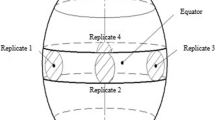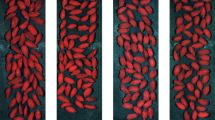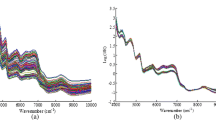Abstract
Tomato cultivation in China is concentrated in Xinjiang, Henan, and Shandong provinces, and the quality of tomatoes produced in different regions shows huge differences. Xinjiang tomatoes have extraordinary nutritional compositions and sensory qualities, and counterfeit Xinjiang tomato products are proliferating in the market. This study aimed to investigate the feasibility of identifying the geographical origin of Chinese tomatoes by using long-wave Fourier-Transform near-infrared spectroscopy (FT-NIR, 10,000–4000 cm−1). First, principal component analysis (PCA) was conducted on the raw spectra, and it was found that the first two PCs effectively identified the geographical origin of the tomatoes. Meanwhile, the results of partial least squares discriminant analysis (PLS-DA) combined with different preprocessing methods showed that the PLS-DA model based on the raw spectra achieved the best performance. The optimal PLS-DA model achieved the correct classification rate (CCR) of 97.8% in an external prediction set, and showed that raw spectra contained sufficient valid information. Besides, six algorithms, grid search (GS), genetic algorithm (GA), particle swarm algorithm (PSO), grey wolf algorithm (GWO), improved grey wolf algorithm (IGWO), and sparrow search algorithm (SSA) were employed to optimize the parameters of support vector machine (SVM). The SSA-SVM model exhibited the best performance with a CCR of 97.8% in the prediction set. Afterward, 40 and 8 spectral features were extracted from the raw full spectra using stacked autoencoder (SAE) and PC loading, respectively. Finally, the qualitative analysis model based on the feature variables was further investigated, and the SAE-SSA-SVM simplified model showed the best performance with a CCR of 98.7%, 95.6%, and 95.6% in the calibration, cross-validation, and prediction set, respectively. The results of this study provide theoretical support for applying long-wave FT-NIRS combined with machine learning and deep learning to tomato origin identification.







Similar content being viewed by others
Data Availability
The data that support the findings of this study are available from the corresponding author upon reasonable request.
References
Ahn J (2018) Characterization of bioactive compounds of domestic tomato varieties. Culinary Sci Hosp Res 24(1):63–72. https://doi.org/10.20878/cshr.2018.24.1.007
Bureau S, Reling P, Bogé M, Garcia C, Renard CMGC, Giovinazzo R, Page D (2017) Rapid characterization of industry-type tomato using mid-infrared spectroscopy. Acta Hortic 1159:183–188
Castro TA, Leite BS, Assunção LS et al (2021) Red tomato products as an alternative to reduce synthetic dyes in the food industry: a review. Molecules 26(23):7125. https://doi.org/10.3390/molecules26237125
Chen Q, Zhao J, Fang CH et al (2007) Feasibility study on identification of green, black and Oolong teas using near-infrared reflectance spectroscopy based on support vector machine (SVM). Spectrochim Acta Part A Mol Biomol Spectrosc 66(3):568–574. https://doi.org/10.1016/j.saa.2006.03.038
Chen Y, Lin Z, Zhao X et al (2014) Deep learning-based classification of hyperspectral data. IEEE J Sel Topics Appl Earth Obs Remote Sens 7(6):2094–2107. https://doi.org/10.1109/JSTARS.2014.2329330
da Costa AZ, Figueroa HEH, Fracarolli JA (2020) Computer vision based detection of external defects on tomatoes using deep learning. Biosys Eng 190:131–144. https://doi.org/10.1016/j.biosystemseng.2019.12.003
D’Angelo M, Zanor MI, Sance M et al (2018) Contrasting metabolic profiles of tasty Andean varieties of tomato fruit in comparison with commercial ones. J Sci Food Agric 98(11):4128–4134. https://doi.org/10.1002/jsfa.8930
Feng L, Zhang M, Adhikari B et al (2019) Nondestructive detection of postharvest quality of cherry tomatoes using a portable NIR spectrometer and chemometric algorithms. Food Anal Methods 12:914–925. https://doi.org/10.1007/s12161-018-01429-9
Gallo M (2010) Discriminant partial least squares analysis on compositional data. Stat Model 10(1):41–56. https://doi.org/10.1177/1471082X0801000103
Guo W, Gu J, Liu D et al (2016) Peach variety identification using near-infrared diffuse reflectance spectroscopy. Comput Electron Agric 123:297–303. https://doi.org/10.1016/j.compag.2016.03.005
Hotelling H (1933) Analysis of a complex of statistical variables into principal components. J Educ Psychol 24(6):417–441. https://doi.org/10.1037/h0071325
Huang Y, Lu R, Chen K (2018) Prediction of firmness parameters of tomatoes by portable visible and near-infrared spectroscopy. J Food Eng 222:185–198. https://doi.org/10.1016/j.jfoodeng.2017.11.030
Huang J, Ren G, Sun Y, Jin S, Li L, Wang Y, Ning J, Zhang Z (2020a) Qualitative Discrimination of Chinese Dianhong black tea grades based on a handheld spectroscopy system coupled with chemometrics. Food Sci Nutr 8(4):2015–2024. https://doi.org/10.1002/fsn3.1489
Huang Y, Si W, Chen K et al (2020b) Assessment of tomato maturity in different layers by spatially Resolved Spectroscopy. Sensors 20(24):7229. https://doi.org/10.3390/s20247229
Jiang H, Ye L, Li X et al (2021a) Variety identification of Chinese walnuts using hyperspectral imaging combined with chemometrics. Appl Sci 11(19):9124. https://doi.org/10.3390/app11199124
Jiang H, Jiang X, Ru Y et al (2021b) Sweetness detection and grading of peaches and nectarines by combining short- and long-wave Fourier-transform near-infrared spectroscopy. Anal Lett 54(7):1125–1144. https://doi.org/10.1080/00032719.2020.1795186
Jiang H, Yuan W, Ru Y et al (2022) Feasibility of identifying the authenticity of fresh and cooked mutton kebabs using visible and near-infrared hyperspectral imaging. Spectrochim Acta Part A: Mol Biomol Spectrosc 282:121689. https://doi.org/10.1016/j.saa.2022.121689
Li F, Qiao R, Yang X et al (2022) Occurrence, distribution, and management of tomato yellow leaf curl virus in China. Phytopathol Res 4(1):28. https://doi.org/10.1186/s42483-022-00133-1
Liu R, Li G, Wei L et al (2022) Spatial prediction of groundwater potentiality using machine learning methods with Grey Wolf and Sparrow Search Algorithms. J Hydrol 610:127977. https://doi.org/10.1016/j.jhydrol.2022.127977
Magwaza LS, Opara UL, Nieuwoudt H et al (2012) NIR spectroscopy applications for internal and external quality analysis of citrus fruit—a review. Food Bioprocess Technol 5(2):425–444. https://doi.org/10.1007/s11947-011-0697-1
Masetti O, Ciampa A, Nisini L, Sequi P, Dell’Abate MT (2017) A Multifactorial approach in characterizing geographical origin of sicilian cherry tomatoes using 1H-NMR profiling. Food Res Int 100:623–630. https://doi.org/10.1016/j.foodres.2017.07.059
Nazarloo AS, Sharabiani VR, Gilandeh YA et al (2021) evaluation of different models for non-destructive detection of tomato pesticide residues based on near-infrared spectroscopy. Sensors 21(9):3032. https://doi.org/10.3390/s21093032
Nikbakht AM, Hashjin TT, Malekfar R, Gobadian B (2011) nondestructive determination of tomato fruit quality parameters using Raman Spectroscopy. J Agric Sci Technol 13(4):517–526
Okere EE, Arendse E, Nieuwoudt H et al (2022) Non-destructive evaluation of the quality characteristics of pomegranate kernel oil by Fourier transform near-infrared and mid-infrared spectroscopy. Front Plant Sci. https://doi.org/10.3389/fpls.2022.867555
Perveen R, Suleria HAR, Anjum FM et al (2015) Tomato (Solanum lycopersicum) Carotenoids and lycopenes chemistry; metabolism, absorption, nutrition, and allied health claims—a comprehensive review. Crit Rev Food Sci Nutr 55(7):919–929. https://doi.org/10.1080/10408398.2012.657809
Petyaev IM (2016) Lycopene deficiency in ageing and cardiovascular disease. Oxidative Med Cell Longev 1:6. https://doi.org/10.1155/2016/3218605
Qiao M, Xu Y, Xia G et al (2022) Determination of hardness for maize kernels based on hyperspectral imaging. Food Chem 366:130559. https://doi.org/10.1016/j.foodchem.2021.130559
Sampaio PS, Castanho A, Almeida AS et al (2020) Identification of rice flour types with near-infrared spectroscopy associated with PLS-DA and SVM methods. Eur Food Res Technol 246(3):527–537. https://doi.org/10.1007/s00217-019-03419-5
Shao Y, He Y, Gómez AH, Pereir AG, Qiu Z, Zhang Y (2007) Visible/near infrared spectrometric technique for nondestructive assessment of tomato ‘heatwave’ (Lycopersicum Esculentum) quality characteristics. J Food Eng 81(4):672–678. https://doi.org/10.1016/j.jfoodeng.2006.12.026
Sirisomboon P, Tanaka M, Kojima T et al (2012) Nondestructive estimation of maturity and textural properties on tomato ‘Momotaro’ by near infrared spectroscopy. J Food Eng 112(3):218–226. https://doi.org/10.1016/j.jfoodeng.2012.04.007
Sun D, Cruz J, Alcala M et al (2021) Near infrared spectroscopy determination of chemical and sensory properties in tomato. J Near Infrared Spectrosc 29(5):289–300. https://doi.org/10.1177/09670335211018759
Tao C, Pan H, Li Y et al (2015) Unsupervised spectral-spatial feature learning with stacked sparse autoencoder for hyperspectral imagery classification. IEEE Geosci Remote Sens Lett 12(12):2438–2442. https://doi.org/10.1109/LGRS.2015.2482520
Wold S, Esbensen K, Geladi P (1987) Principal component analysis. Chemom Intell Lab Syst 2(1):37–52. https://doi.org/10.1016/0169-7439(87)80084-9
Wu N, Zhang C, Bai X et al (2018) Discrimination of chrysanthemum varieties using hyperspectral imaging combined with a deep convolutional neural network. Molecules 23(11):2831. https://doi.org/10.3390/molecules23112831
Xie L, Ying Y, Ying T (2009) Classification of tomatoes with different genotypes by visible and short-wave near-infrared spectroscopy with least-squares support vector machines and other chemometrics. J Food Eng 94(1):34–39. https://doi.org/10.1016/j.jfoodeng.2009.02.023
Xu HR, Ying YB, Fu XP et al (2007) Near-infrared Spectroscopy in detecting Leaf Miner Damage on Tomato Leaf. Biosys Eng 96(4):447–454. https://doi.org/10.1016/j.biosystemseng.2007.01.008
Xu W, Jiang H, Liu T, He Y, Chen Q (2019) Qualitative discrimination of yeast fermentation stages based on an olfactory visualization sensor system integrated with a pattern recognition algorithm. Anal Methods 11(26):3294–3300. https://doi.org/10.1039/C9AY00760A
Xu M, Sun J, Yao K et al (2022) Developing deep learning based regression approaches for prediction of firmness and pH in Kyoho grape using Vis/NIR hyperspectral imaging. Infrared Physics Tech 120:104003. https://doi.org/10.1016/j.infrared.2021.104003
Xue J, Shen B (2020) A novel swarm intelligence optimization approach: sparrow search algorithm. Syst Sci Control Eng 8(1):22–34. https://doi.org/10.1080/21642583.2019.1708830
Yang D, Yuan J, Chang Q et al (2020) Early determination of mildew status in storage maize kernels using hyperspectral imaging combined with the stacked sparse auto-encoder algorithm. Infrared Physics Tech 109:103412. https://doi.org/10.1016/j.infrared.2020.103412
Yu X, Lu H, Liu Q (2018) Deep-learning-based regression model and hyperspectral imaging for rapid detection of nitrogen concentration in oilseed rape (Brassica napus L.) leaf. Chemom Intell Lab Syst 172:188–193. https://doi.org/10.1016/j.chemolab.2017.12.010
Yu X, Lu H, Wu D (2018b) Development of deep learning method for predicting firmness and soluble solid content of postharvest Korla fragrant pear using Vis/NIR hyperspectral reflectance imaging. Postharvest Biol Technol 141:39–49. https://doi.org/10.1016/j.postharvbio.2018.02.013
Yu X, Tang L, Wu X et al (2018c) Nondestructive freshness discriminating of shrimp using visible/near-infrared hyperspectral imaging technique and deep learning algorithm. Food Anal Methods 11(3):768–780. https://doi.org/10.1007/s12161-017-1050-8
Yu X, Wang J, Wen S et al (2019a) A deep learning based feature extraction method on hyperspectral images for nondestructive prediction of TVB-N content in Pacific white shrimp (Litopenaeus vannamei). Biosys Eng 178:244–255. https://doi.org/10.1016/j.biosystemseng.2018.11.018
Yu X, Yu X, Wen S et al (2019b) Using deep learning and hyperspectral imaging to predict total viable count (TVC) in peeled Pacific white shrimp. J Food Meas Charact 13(3):2082–2094. https://doi.org/10.1007/s11694-019-00129-0
Zhang L, McCarthy MJ (2012) Measurement and evaluation of tomato maturity using magnetic resonance imaging. Postharvest Biol Technol 67:37–43. https://doi.org/10.1016/j.postharvbio.2011.12.004
Zhao D, Wang Z, Zhang J et al (2019) Improving yield and quality of processing tomato (Lycopersicon esculentum Miller) using alternate partial root-zone drip irrigation in Arid Northwest China. Water 11(7):1503. https://doi.org/10.3390/w11071503
FAO. Food and Agriculture Data. Available online: https://www.fao.org/faostat/en/#data/QCL (accessed on 3 September 2022)
Funding
This work was supported by National Natural Science Foundation of China [grant number 32102071] and the Natural Science Foundation of the Jiangsu Higher Education Institutions of China [grant number 21KJB220013].
Author information
Authors and Affiliations
Contributions
Weidong Yuan: Methodology, data curation, investigation, validation, funding acquisition, writing—original draft. Hongzhe Jiang: conceptualization, writing—review & editing. Mengmeng Sun: data curation, software. Yu Zhou: formal analysis, methodology. Cong Zhang: investigation. Hongping Zhou: conceptualization, writing—review & editing.
Corresponding author
Ethics declarations
Competing Interests
Weidong Yuan declares that he has no conflict of interest. Hongzhe Jiang declares that she has no conflict of interest. Mengmeng Sun declares that she has no conflict of interest. Yu Zhou declares that he has no conflict of interest. Cong Zhang declares that he has no conflict of interest. Hongping Zhou declares that he has no conflict of interest.
Additional information
Publisher's Note
Springer Nature remains neutral with regard to jurisdictional claims in published maps and institutional affiliations.
Rights and permissions
Springer Nature or its licensor (e.g. a society or other partner) holds exclusive rights to this article under a publishing agreement with the author(s) or other rightsholder(s); author self-archiving of the accepted manuscript version of this article is solely governed by the terms of such publishing agreement and applicable law.
About this article
Cite this article
Yuan, W., Jiang, H., Sun, M. et al. Geographical Origin Identification of Chinese Tomatoes Using Long-Wave Fourier-Transform Near-Infrared Spectroscopy Combined with Deep Learning Methods. Food Anal. Methods 16, 664–676 (2023). https://doi.org/10.1007/s12161-023-02444-1
Received:
Accepted:
Published:
Issue Date:
DOI: https://doi.org/10.1007/s12161-023-02444-1




